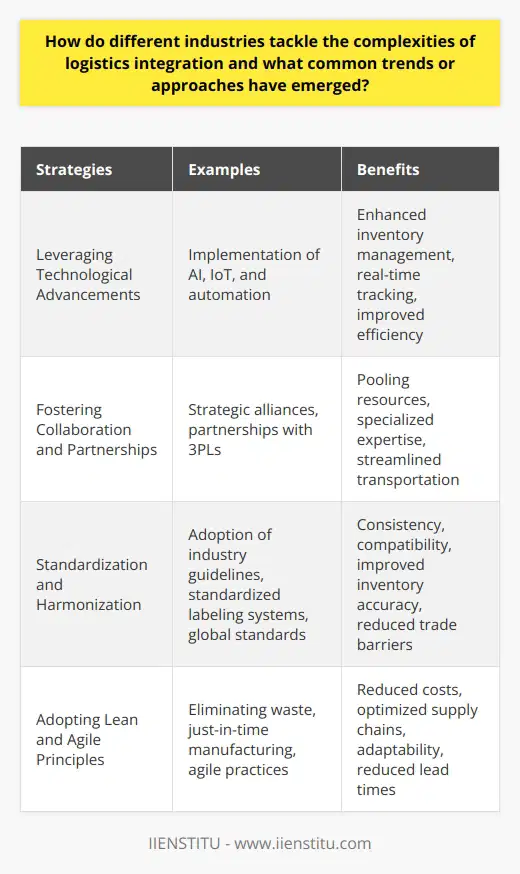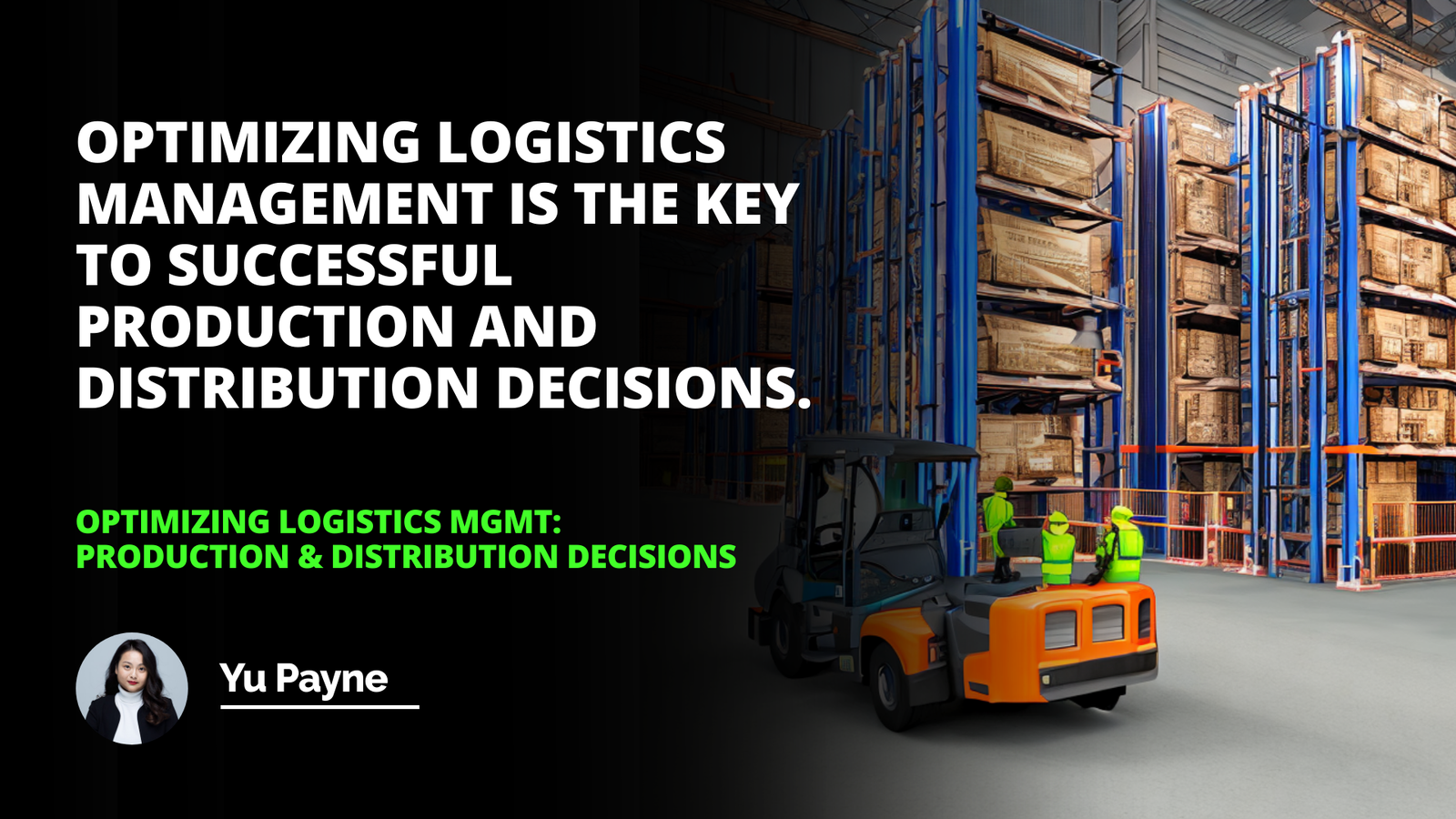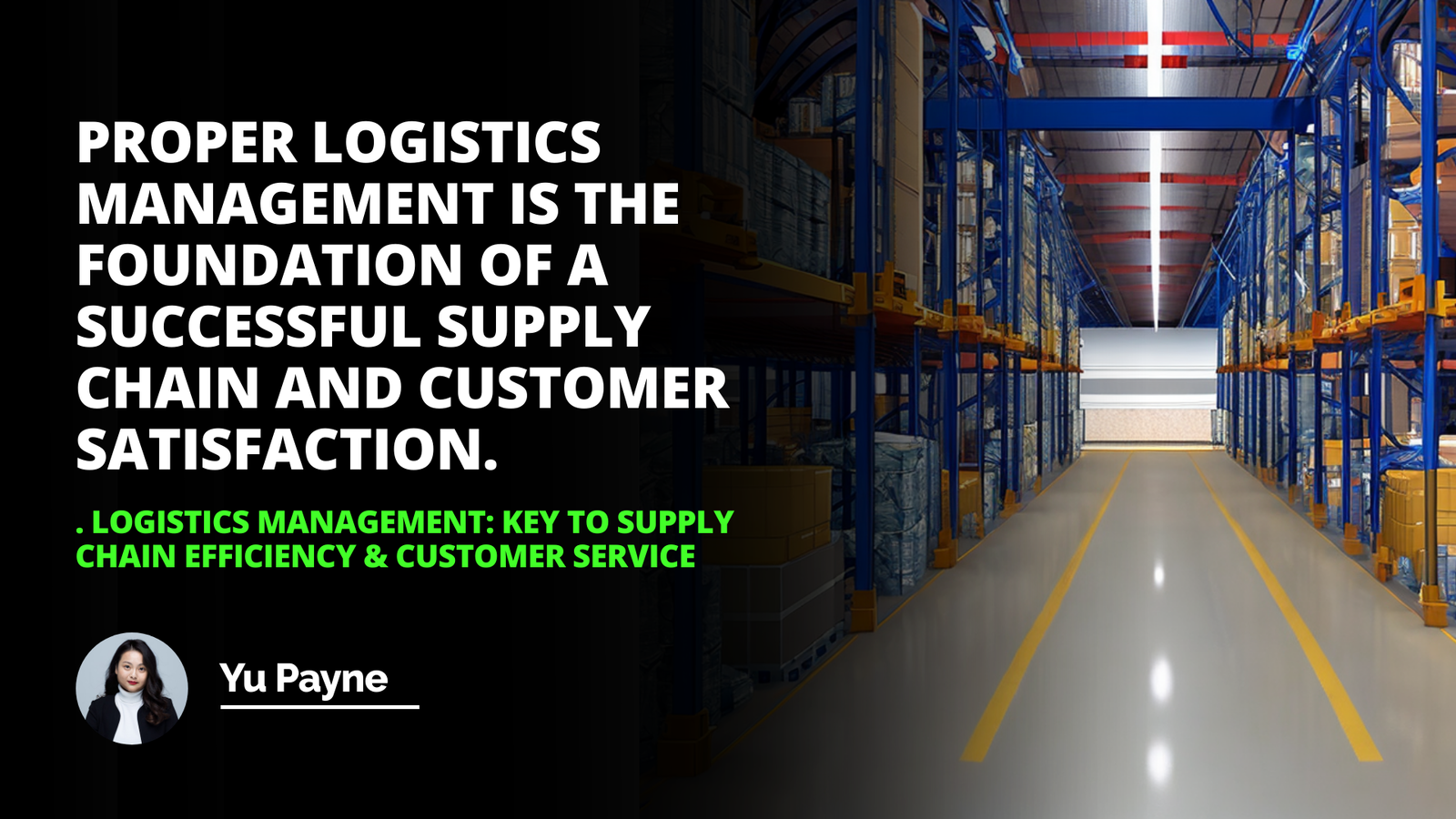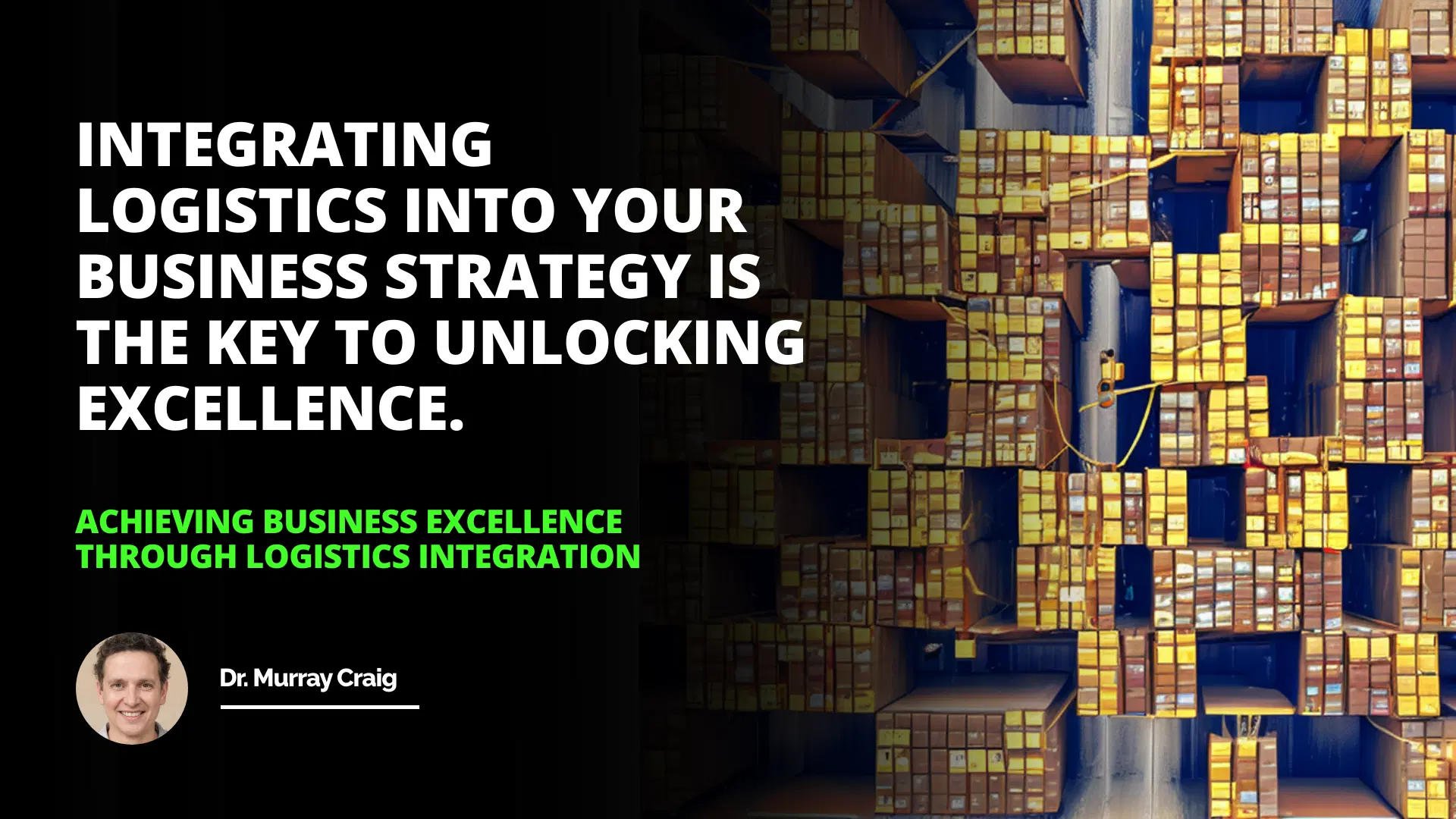
Benefits of Logistics Integration
Implementing Logistics Integration
Challenges of Logistics Integration
Business excellence is a goal for any modern organization, and logistics integration is one of the most effective ways of achieving this goal. Logistics integration involves integrating warehouses, delivery systems, supply chains, and other distribution processes to maximize the effectiveness of each. By combining these, organizations can move goods and services more quickly and efficiently while providing better customer service and reducing costs. Logistics integration is an idea that has been around since the industrial revolution, and it is still highly applicable today.
Benefits of Logistics Integration
One of the most significant benefits of logistics integration is improved efficiency. By integrating the various aspects of a supply chain, businesses can reduce delays, identify bottlenecks, and minimize redundancy in their processes. This can result in shorter lead times and higher returns on investments. Additionally, integrating logistics operations can also result in enhanced customer service. Customers can receive products faster and more reliably, with fewer issues regarding delivery and shipment. Finally, integrating logistics operations can significantly reduce operational expenses by eliminating redundancy, streamlining processes, and optimizing supply chains.
Implementing Logistics Integration
If businesses want to take advantage of the benefits of logistics integration, they must begin by conducting a process review. This review should examine the organization’s current systems, procedures, and processes to identify potential bottlenecks or areas where efficiency can be improved. Once the analysis is completed, complete businesses should establish logistical procedures that ensure the proper tracking and management of orders, inventory, and shipments. Additionally, companies should utilize technology to streamline the process, such as using data-driven insights to optimize chain strategies. This can result in improved visibility, better forecasting and planning, and reduced reliance on manual processes.
Challenges of Logistics Integration
Though there are many benefits to implementing logistics integration, some challenges must be faced. One of the most significant is aligning the logistical strategy with the business’s overall goals. This requires a ding of the business’s overall vision, as well as an in-depth knowledge of the logistics industry. Additionally, the successful implementation of logistics integration invariably requires collaboration among multiple departments, vendors, and partners. As such, they are gaining the necessary cooperation to ensure successful integration can be challenging.
Conclusion: Logistinot easy on is a powerful tool for achieving business excellence and can result in several key benefits. Efficiency improvements, enhanced customer service, and cost reductions are among the main advantages businesses can experience when they integrate their logistical operations. Implementing logic integration can be a complex process, however, and requires a thorough process review, well-defined procedures, and technology adoption to ensure its success. Additionally, businesses must ensure that their logistical strategy aligns with their long-term goals. Nevertheless, with proper implementation, organizations can reap aligns logistical operations and create value for their stakeholders.
Achieving Reliable Delivery Performance in Logistics Management
Unleashing the Power of Logistics for 30-Minute Pizza Delivery
Optimizing Logistics Management: Transportation Modes & Costs
Exploring the Impact of Real-Time Tracking and Tracing in Supply Chain Operations
Integrating logistics into your business strategy is the key to unlocking excellence.
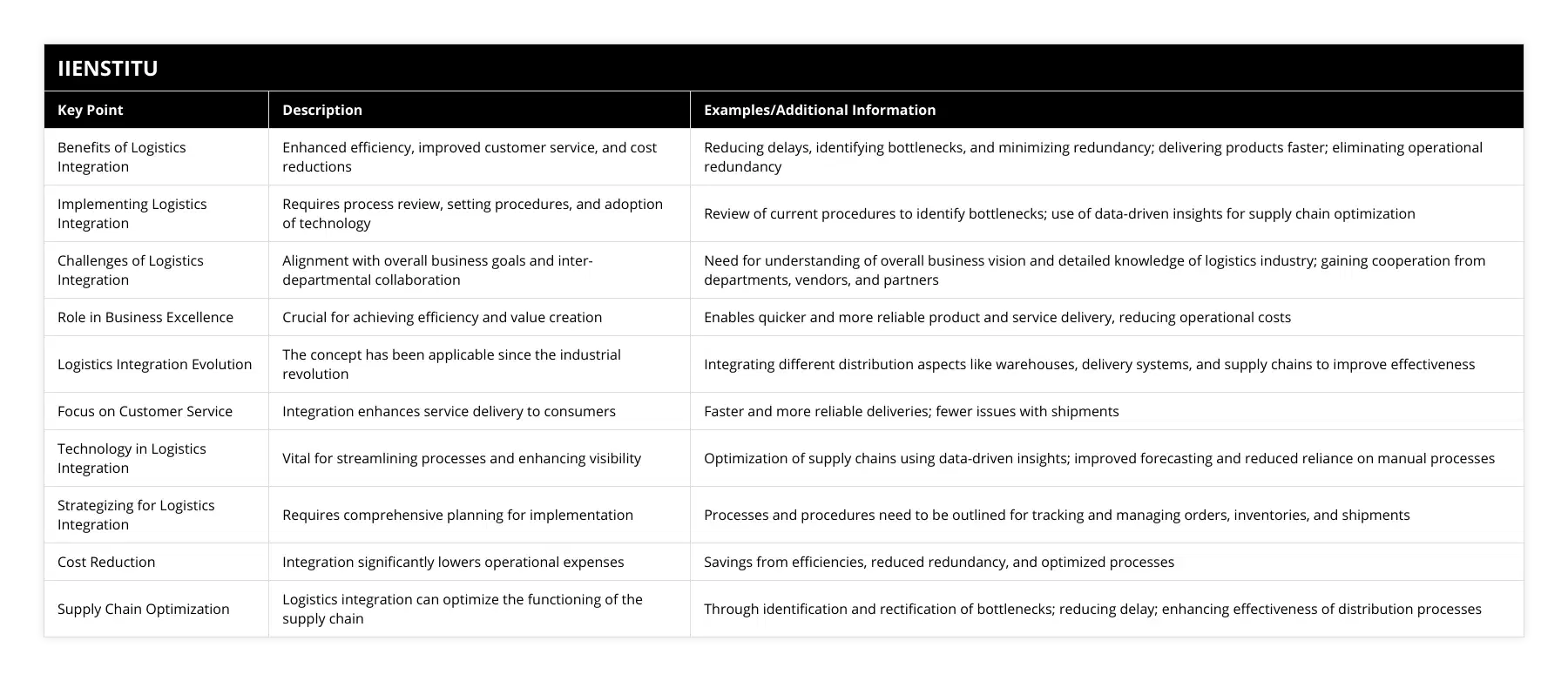
Frequently Asked Questions
What are the benefits of achieving business excellence through logistics integration?
The global business landscape has become increasingly complex, and businesses are constantly challenged to achieve excellence in their operations. Logistics integration is crucial to conducting business excellence, and numerous advantages are associated. Through the coordination of all components of the logistics process, businesses can optimize their supply chains and operations, maximize customer service, and improve their competitive advantage.
One of the key benefits of integrating logistics within a business is the ability to reduce risk and increase efficiency through a streamlined, centralized process. By standardizing activities across the supply chain, companies can reduce the potential for errors, streamline operations, and ultimately reduce costs. In addition, consolidated supply chains increase visibility and control of resources, reducing waiting times and storage and transport costs. This leads to faster delivery times and improved customer service.
Integrated logistics also allows businesses to improve customer service. Through integrated logistics, companies allow customers direct access to all the data they need, providing them with high service, transparency, and convenience. Furthermore, integrated logistics systems enable businesses to anticipate the needs of their customers better, leading to increased customer satisfaction.
Finally, integrated logistics helps businesses gain a competitive advantage in the market. By optimizing their operations and enabling more efficient, effective, and cost-effective processes, companies can more effectively compete against their rivals and position themselves as a leader in their industry. Moreover, integrated logistics systems help businesses move quickly to respond to customer demands and seize any opportunities that may arise.
In conclusion, achieving business excellence through logistics integration provides numerous business advantages. By coordinating all supply chain components, businesses can reduce the risk of errors, optimize operations, and improve customer service. In addition, they can gain a competitive advantage in the market and better respond to customer demands. The benefits of integrated logistics are undeniable, and businesses should consider adopting it to remain competitive in the modern marketplace.

What criteria or standards should be used when assessing an integrated logistics system for business excellence?
Business operations and processes today are built on integrated logistics systems that optimize the movement of materials and services between suppliers and customers. This integrated approach relies on up-to-date technology and processes that enable businesses to provide customers with the best quality services at the lowest cost. It is, therefore, crucial for companies to evaluate their integrated logistics systems for business excellence.
Companies should consider multiple criteria when assessing an integrated logistics system for business excellence. Firstly, the ability of the system to meet customer demands should be set. This means evaluating the power of the system to accurately and efficiently forecast customer demand, plan and schedule production and purchase orders, and monitor customer satisfaction. Additionally, companies should assess the capability of the system to meet desired in-transit time, inventory levels, and shipment accuracy.
Company performance and operational cost should also be considered when assessing an integrated logistics system for business excellence. Companies should measure the overall performance of their integrated logistics system by analyzing various efficiency metrics such as labor, warehouse, and transportation cost. In addition, performance goals like order fill rate and inventory management should be tracked to evaluate the system's profitability and ensure the system is cost-effective.
Finally, a company should evaluate the scalability and flexibility of its integrated logistics system for business excellence. An adequate system should scale according to the changing customer demand, production, and order patterns. Companies should also consider how the system is planned and implemented to accommodate growth, changing technology, and changing customer requirements.
In conclusion, an integrated logistics system should be assessed for business excellence using several criteria. First, companies should evaluate the capability of the system to meet customer demands, performance and cost goals, and the scalability and flexibility of the system. This will enable them to assess the overall effectiveness of their design and ensure that it provides the best services and cost-effectiveness for their customers.
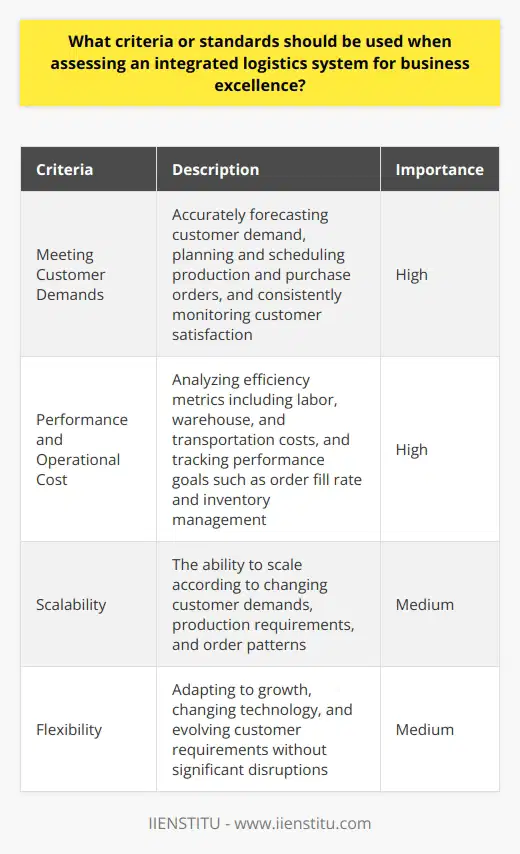
What best practices can be employed to ensure successful logistics integration and help achieve business excellence?
Logistics integration is a process that requires companies to better coordinate the product flow, delivery times, and transportation to enable the delivery of products and services of higher quality and lower cost. Proper logistics integration can help companies remain competitive and improve their competitiveness in the global market. This article discusses critical best practices for successful logistics integration and how they can be employed to help achieve business excellence.
The first best practice is to ensure that logistics procedures are designed in a way that integrates all relevant stakeholders. This involves adequate communication between business teams, customers, suppliers, and partners. The process should be prepared to accommodate the needs of all stakeholders to achieve a complete understanding of the business objectives and processes. The goal is to develop an accurate supply chain model that can address future needs and provide greater flexibility in the system.
Second, developing and maintaining effective relationships with logistics partners is essential. Logistics partners can provide cost-effective solutions and provide reliable and timely transport options. This is especially important for global operations since it allows multinational businesses to access a broader range of supply chain services, such as freight forwarders or customs agents, to maximize operational efficiency. In addition, maintaining a good working relationship with existing partners and seeking out new ones when needed can help ensure successful logistics integration.
Third, businesses should invest in modern technology systems supporting near real-time end-to-end supply chain visibility. Many organizations rely heavily on older custom-built systems and processes; however, more is needed for accurate insights and a detailed order and shipment status analysis. By investing in modern designs, organizations can access data drastically, improving their supply chain operations' visibility, efficiency, and accuracy.
Finally, businesses should establish delivery benchmarking and service standards to keep track of their performance in the logistics process. Setting delivery benchmarking standards can help understand customer needs and desires and provide insight into the supply chain performance and areas of improvement. This allows companies to continuously adjust their operations and offerings to meet customer's expectations while maximizing profit margins.
In conclusion, successful logistics integration can be a challenging endeavor. Still, increased visibility, communication, collaboration, and technology investments can help businesses achieve business excellence. Companies that adopt these best practices are in the best position to remain competitive and continue delivering the highest quality products and services.

How does logistics integration contribute to achieving business excellence?
Logistics Integration: A Key Factor in Business Excellence
Logistics integration plays a significant role in achieving business excellence by streamlining the flow of goods, information, and resources across various departments and operations. Companies that embrace a highly-integrated logistics system can effectively optimize their supply chain processes and achieve greater efficiency, resulting in a competitive advantage for the business.
Efficient Resource Allocation
One primary benefit of logistics integration is the efficient allocation and utilization of resources. An effective logistics system allows businesses to minimize costs and reduce waste by consistently aligning the available resources with customer demands. As a result, companies can ensure that the right products are available at the right time and place, thereby enhancing customer satisfaction and overall business performance.
Increased Collaboration and Communication
An integrated logistics system fosters collaboration and communication among different stakeholders, including suppliers, customers, and various internal departments. This improved level of communication and information sharing enables businesses to react quickly to market changes and customer needs, ultimately contributing to the organization's agility and responsiveness.
Enhanced Visibility and Transparency
Logistics integration provides companies with increased visibility and transparency throughout the supply chain. This improved insight allows for better decision-making and monitoring of key performance indicators (KPIs), enabling businesses to identify areas for improvement and take corrective action when needed. Furthermore, enhanced visibility and transparency can help organizations mitigate risks and anticipate potential disruptions, allowing them to grow and maintain a competitive edge in the market.
Improved Customer Service
Comprehensive logistics integration also contributes to superior customer service. By having a well-established logistics system, companies can fulfill customer requests and demands in a more timely and efficient manner. This ability directly translates to higher levels of customer satisfaction, resulting in increased loyalty and repeated business, which positively impacts the company's bottom line.
In conclusion, logistics integration is a crucial component in achieving business excellence. By implementing an integrated logistics system, companies can allocate resources more efficiently, enhance communication and collaboration, increase visibility and transparency, and improve customer service. Through these benefits, organizations can optimize their supply chain processes, gain a competitive advantage in the market, and ultimately, achieve business excellence.

What are the key components of a well-integrated logistics system, and how do they promote business excellence?
Key Components of Integrated Logistics
A well-integrated logistics system comprises several key components that work in harmony to ensure smooth and efficient operations. These components promote business excellence by enhancing product delivery, optimizing inventory management, and improving overall operational efficiency.
Effective Transport Management
Firstly, effective transport management is crucial for timely and cost-efficient delivery of products and services. By employing advanced technologies and optimizing routes, companies can minimize transportation costs, improve shipment tracking, and enhance customer satisfaction through accurate delivery timelines.
Inventory Optimization
Secondly, inventory optimization is essential for a well-integrated logistics system. With the right balance of inventory levels, businesses can ensure that customers promptly receive the products they need while reducing the costs associated with warehousing excess stock. Implementing just-in-time inventory and demand forecasting methods are key strategies to achieve this objective.
Integrated Information Systems
The adoption of integrated information systems is another important aspect of a well-integrated logistics system. These systems streamline communication and data-sharing between departments and functions, allowing companies to make better-informed decisions based on real-time information. Improved information flow contributes to business excellence through boosted operational efficiency, faster response rates, and increased overall visibility.
Supplier Collaboration
Effective collaboration with suppliers is also vital within an integrated logistics system. By fostering strong relationships with suppliers, businesses can ensure that all raw materials and products are procured and delivered according to specifications and deadlines. This cooperation promotes business excellence by minimizing disruptions in the supply chain, improving product quality, and reducing procurement costs.
Performance Measurement and Continuous Improvement
Lastly, measuring performance and implementing continuous improvements are integral to achieving and sustaining business excellence. By monitoring key performance indicators, such as delivery times, customer satisfaction, and inventory turnover, companies can identify areas for improvement, implement corrective actions, and continuously streamline their logistics operations.
In conclusion, the key components of a well-integrated logistics system, including effective transport management, inventory optimization, integrated information systems, supplier collaboration, and performance measurement, all contribute to promoting business excellence. By investing in these components, businesses can improve their overall efficiency, reduce operational costs, and ultimately enhance customer satisfaction.
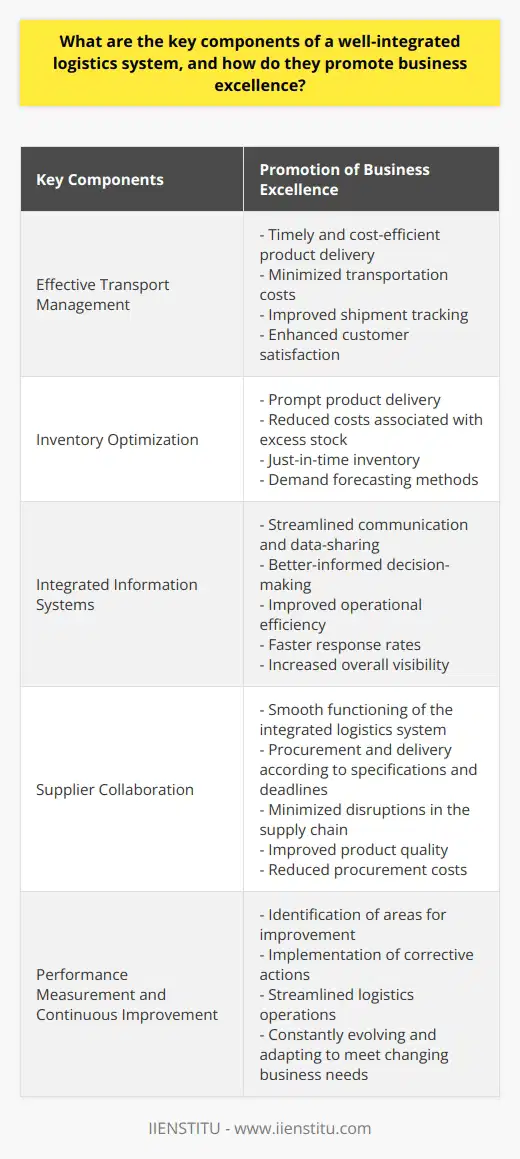
Can you provide examples of companies that have successfully achieved business excellence through effective logistics integration?
Logistics Integration in Global Companies
Major global companies have consistently demonstrated excellence in their business operations by integrating effective logistics practices. Two such examples are Walmart and Amazon, both of which have achieved significant success through streamlined logistics strategies.
Walmart's Supply Chain Management Strategy
Walmart, a multinational retail corporation, has consistently pursued supply chain management (SCM) strategies as a core element of its business growth. The company upholds a Just-In-Time (JIT) approach, maintaining limited stock and relying on frequent supply deliveries to replenish the inventory. Walmart's extensive distribution network includes over 150 distribution centers, ensuring swift supply chain operations.
Moreover, Walmart leverages data-driven decision-making by implementing cutting-edge technology, such as the Retail Link System (RLS), to collect and analyze valuable information. The company shares this information with suppliers, fostering a strong collaborative relationship, which results in reduced lead times and improved efficiency.
Amazon's E-commerce Logistics Strategy
Amazon, the world's largest e-commerce platform, owes a significant portion of its success to an effective logistics strategy. The company possesses a vast distribution network with numerous strategically located fulfillment centers, allowing it to deliver products to consumers promptly.
In order to optimize inventory management, Amazon leverages advanced forecasting algorithms that predict demand patterns and adjust stock levels accordingly. This approach ensures product availability while minimizing excess inventory costs.
Additionally, Amazon invests in innovative logistics technologies to speed up and automate its processes. A prime example is the company's deployment of robotics in its fulfillment centers, improving efficiency, and reducing human error. The use of such advanced technologies reinforces Amazon's competitive edge in the e-commerce industry.
In conclusion, companies like Walmart and Amazon exemplify the benefits of an effective logistics integration strategy. By optimizing supply chain operations, these companies streamline their business processes and significantly contribute to their overall success.

How do you achieve integration in logistics?
Strategic Planning and Collaboration
Achieving integration in logistics requires strategic planning and collaboration between different stakeholders involved in the supply chain. This typically involves coordinating and streamlining activities of suppliers, manufacturers, distributors, and retailers to optimize efficiency, reduce costs, and improve customer satisfaction.
Technology and Data Sharing
A major aspect of integration in logistics is the use of technology and data sharing. Organizations can implement software solutions such as Enterprise Resource Planning (ERP) systems, Warehouse Management Systems (WMS), and Transportation Management Systems (TMS) to facilitate communication and information flow between different supply chain partners. The seamless exchange of critical data, such as inventory levels, demand forecasts, and shipment schedules, helps to ensure the smooth functioning of the entire supply chain.
Process Standardization and Automation
Another essential component for achieving logistics integration is the standardization and automation of processes. By establishing consistent procedures and policies across different aspects of the supply chain, organizations can enhance efficiency and minimize errors. Automation technologies, such as robotics and artificial intelligence, can be employed to replace repetitive and time-consuming tasks, enabling employees to focus on more value-added activities.
Continuous Improvement and Adaptability
Supply chain integration necessitates a commitment to continuous improvement and adaptability. This can be accomplished by measuring and tracking key performance indicators (KPIs) that gauge the effectiveness of various supply chain processes. By routinely assessing these metrics, organizations can identify areas for improvement and implement effective solutions. Additionally, being adaptable to changing market conditions and customer preferences is a vital aspect of achieving logistics integration.
Cross-Functional Training and Employee Engagement
Finally, fostering cross-functional training and employee engagement are crucial components of integrating logistics. By encouraging employees to develop skills and knowledge related to different aspects of the supply chain, organizations can benefit from a more versatile and collaborative workforce, ultimately facilitating better coordination among various stakeholders.
In conclusion, achieving integration in logistics necessitates a multifaceted approach, encompassing strategic planning and collaboration, the use of technology and data sharing, process standardization and automation, continuous improvement, and employee involvement. These elements, when implemented effectively, can lead to a seamless and well-coordinated supply chain that enhances operational efficiency and customer satisfaction.
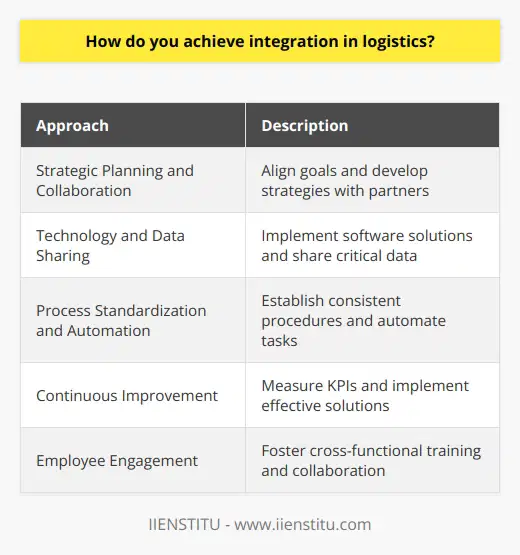
What are the benefits of logistics integration?
Enhanced Efficiency and Cost Reduction
One of the crucial benefits of logistics integration is enhanced efficiency, which results from streamlining operations and minimizing redundancies. By consolidating various logistics functions such as supply chain management, transportation, warehousing, and inventory management, businesses can effectively reduce operational costs and improve overall productivity. Reduced overhead expenses and wastage expedite the flow of goods and services, thereby optimizing the supply chain and making it more responsive to the customers' changing needs.
Improved Coordination and Communication
Logistics integration provides a platform for effective communication and coordination among different departments and stakeholders, thereby fostering a collaborative environment. Harmonized operations facilitate seamless information flow, enabling better decision-making and rapid problem-solving. As a result, businesses can respond quickly to disruptions, manage risks, and adapt to evolving market dynamics. Consequently, an integrated logistics system encourages collaborative planning, forecasting, and replenishment, paving the way for better supply chain visibility.
Higher Flexibility and Scalability
The adoption of an integrated logistics approach provides organizations with the flexibility and scalability essential for managing the rapidly changing business landscape. By leveraging technology and innovative practices, businesses can easily adapt to fluctuations in demand and supply. Integrated logistics systems support the development of modular and adaptable processes that can be scaled up or down depending on the prevailing market conditions. Moreover, this allows businesses to be agile and react promptly to unforeseen challenges, enhancing their competitiveness and resilience.
Increased Customer Satisfaction
Logistics integration leads to a more customer-centric approach in supply chain management, resulting in higher satisfaction levels. When organizations focus on streamlining processes and reducing lead times, they naturally enhance the quality of their services. This, in turn, translates into a better experience for the customers, who receive their products faster and at a lower cost. Furthermore, efficient logistics processes contribute to improved order accuracy, which eliminates errors and enhances customer confidence in the organization.
Environmental Sustainability
Lastly, a well-integrated logistics system promotes environmental sustainability. The optimization of transportation routes, efficient inventory management, and reduced waste generation contribute to minimizing the ecological footprint of logistics operations. By incorporating green practices, such as using alternative fuels, adopting energy-efficient technologies, and minimizing packaging waste, businesses can underscore their commitment to ethical and environmentally responsible practices.
In conclusion, logistics integration offers multiple benefits, including enhanced efficiency, improved coordination, increased flexibility and scalability, higher customer satisfaction, and a focus on environmental sustainability. By adopting an integrated logistics approach, organizations can effectively optimize their supply chain, resolve challenges, and maintain a competitive edge in today's dynamic market.
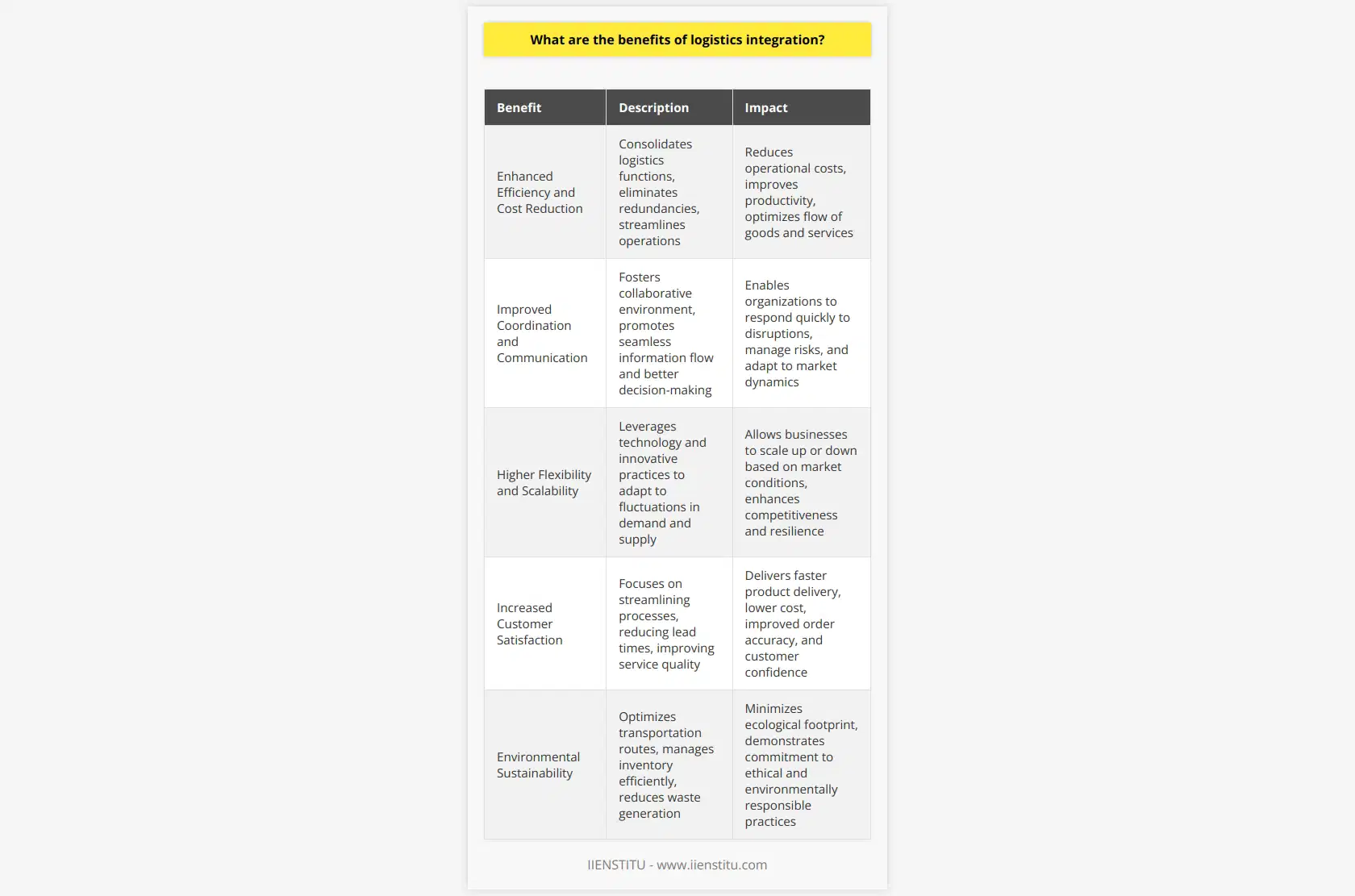
How does logistics integration impact performance?
Logistics Integration and Performance Enhancement
Effectiveness of operations is a crucial factor in the overall success of any business organization. One way companies achieve this is through logistics integration, which significantly impacts performance.
Streamlining Processes
Logistics integration aims to streamline processes across various supply chain operations. This is achieved by enhancing coordination and communication between different departments, such as procurement, production, warehousing, and transportation. By aligning their goals and strategies, businesses can ensure resources are utilized optimally, leading to increased efficiency and reduced costs.
Data-driven Decision-making
Data plays a crucial role in the management of logistics integration. Accurate and timely information enables companies to make informed decisions about product movement and storage. Implementation of advanced software systems allows for real-time data analysis and better management of inventory levels, reducing lead times, and improving customer satisfaction.
Improved Flexibility and Adaptability
Integrated logistics fosters an environment of adaptability and flexibility within a company's supply chain. In today's competitive market, businesses must quickly respond to changes in customer demands, regulations, or other external factors. By maintaining a close alignment of operations, organizations can effectively adapt to these changes and maintain a high level of performance.
Excels in Meeting Customer Demands
Logistics integration facilitates timely delivery and distribution of products to customers, ensuring satisfaction and loyalty. Effective synchronization between supply chain components enables companies to anticipate and adapt to changes in customer needs, improving service levels, and maintaining a competitive edge.
In conclusion, logistics integration has a significant impact on a company's performance. By streamlining processes, driving data-driven decision-making, and fostering flexibility and adaptability, businesses can enhance the proficiency of their supply chain operations. This results in improved customer satisfaction and a competitive advantage in the market.

What are the 6 operational objectives of logistical integration?
Logistical Integration Objectives
Effective logistical integration is essential for businesses seeking to optimize and streamline their supply chain operations. In particular, six operational objectives are critical to achieving successful logistical integration: cost reduction, customer service improvement, flexibility enhancement, resource optimization, risk minimization, and innovation encouragement. These objectives ensure that businesses remain competitive in the market while constantly working to improve their operations and adapt to changing circumstances.
Cost Reduction
Reducing costs is a primary goal of logistical integration, as it enables companies to improve profitability and maintain competitiveness within the market. By consolidating resources and streamlining processes, businesses can eliminate waste, enhance efficiency, and minimize expenses throughout the supply chain.
Customer Service Improvement
Improving customer service is crucial, as it helps businesses differentiate themselves from competitors and build long-lasting relationships with their clients. Logistical integration aims to enhance the quality of customer service provided by ensuring on-time delivery, accurate order fulfillment, and prompt response to customer inquiries.
Flexibility Enhancement
Enhancing flexibility is another vital objective of logistical integration. In today's rapidly changing business landscape, the ability to adapt to new market trends, customer demands, and unforeseen circumstances is essential for organizations. Integrating supply chain components fosters agility and adaptability, allowing companies to respond effectively to change.
Resource Optimization
Efficient utilization of resources is a key element in achieving logistical integration. Businesses should strive to optimize their management of assets, labor, and information, ensuring an effective flow of these resources throughout their supply chain. This optimization ultimately increases productivity and contributes to overall business success.
Risk Minimization
Minimizing risk is essential in any supply chain operation. Logistical integration actively works to mitigate risks associated with disruptions, delays, or losses, by establishing robust and resilient processes throughout the entire supply chain network. This risk minimization supports business continuity and safeguards organizations from potential adverse effects.
Innovation Encouragement
Lastly, encouraging innovation is an important objective of logistical integration. By promoting collaboration between different supply chain components and stakeholders, businesses foster an environment conducive to the development of innovative solutions. This encourages continuous improvement and supports the company's long-term growth and success.
In conclusion, these six operational objectives are critical to successfully achieve logistical integration. Through their implementation, companies can streamline their supply chain processes, optimize resource use, minimize risks, improve customer service, and increase adaptability and innovation, ensuring long-term success and competitiveness in the market.
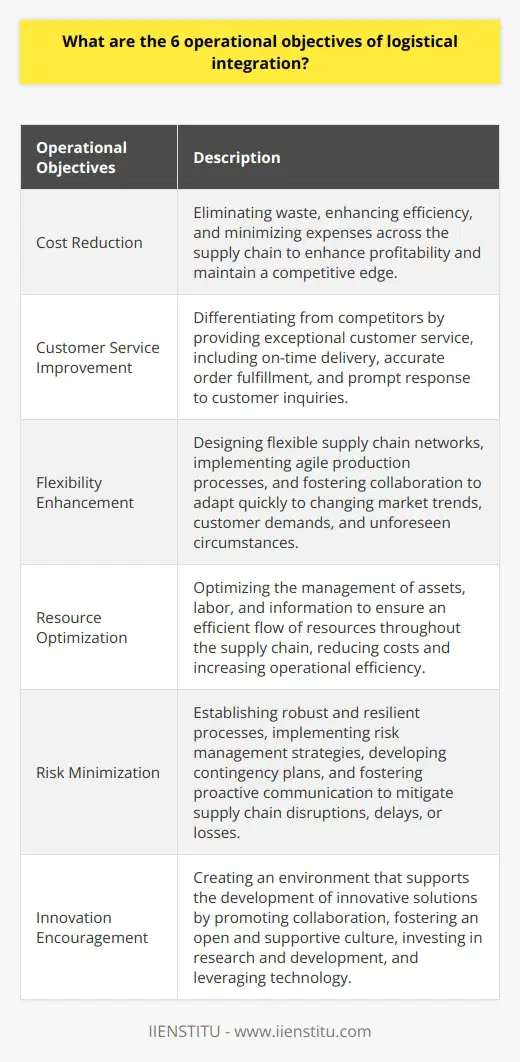
How can technology advancements facilitate logistics integration, and what challenges do they pose?
Technology in Logistics Integration
The rapid development of technology has led to significant advancements in logistics integration, enabling businesses to streamline their supply chain processes and enhance overall efficiency. One way technology facilitates logistics integration is through sophisticated software tools that promote real-time communication and transparency among suppliers, manufacturers, and distributors. These tools allow for enhanced coordination, optimize inventory levels, and ensure timely delivery of goods, ultimately improving customer satisfaction.
Challenges Posed by Technology
However, the adoption of advanced technology in logistics integration also poses several challenges. First, there is the issue of significant financial investments required for implementing and maintaining these systems. Smaller businesses may struggle to allocate resources for technology integration, which could inhibit their ability to compete effectively in the market.
Cybersecurity Risks
Another challenge is the increased vulnerability to cybersecurity threats. As technology continues to evolve, so do cyberattacks, which can lead to disruptions in logistics operations, loss of sensitive data, and damage to a company's reputation. It is crucial for businesses to invest in robust security measures to protect their systems, data, and operations from potential threats.
Compatibility and Interoperability Issues
Additionally, compatibility and interoperability issues can arise among different systems and software tools used by logistics partners. This can hinder efficient data sharing and collaborative decision-making, undermining the benefits of logistics integration. To address this, businesses must ensure that their technology platforms are compatible with their partners' systems, and establish clear protocols for data sharing and communication.
Skill Requirements and Training
Lastly, the adoption of advanced technology in logistics requires employees with specialized skills, which can be difficult to find in a competitive job market. Furthermore, the rapid pace of technological development necessitates ongoing training and skill development for employees to keep up with the latest tools and systems. Companies must invest in skill development programs, and incorporate training as an essential part of their long-term logistics integration strategy.
In conclusion, while technology advancements in logistics integration offer enormous potential for streamlining processes and enhancing efficiency, they also pose challenges that businesses must address. By investing in employee training, security measures, and ensuring compatibility among systems, companies can effectively harness the potential of technology to improve their logistics operations and achieve a competitive edge in the market.
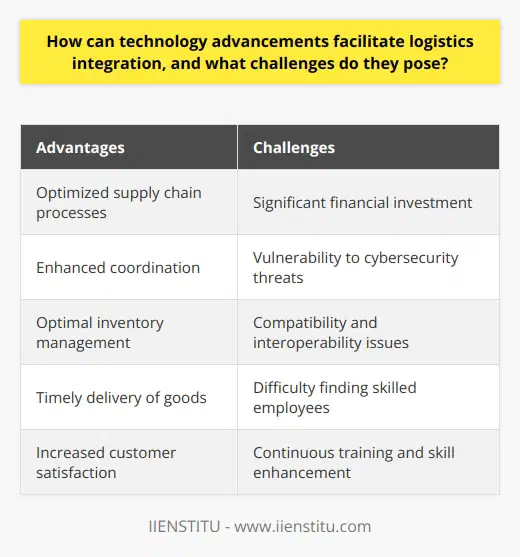
How do different industries tackle the complexities of logistics integration and what common trends or approaches have emerged?
**Integration Strategies in Various Industries**
Different industries tackle the complexities of logistics integration by adopting several approaches, including technological advancements, collaboration, and standardization. These approaches streamline supply chain management, enhance efficiency, and facilitate the achievement of organizational objectives.
**Leveraging Technological Advancements**
Industries utilize technological advancements, such as AI, IoT, and automation, to optimize logistics operations. For instance, transportation and warehousing sectors increasingly adopt systems that use predictive analytics and real-time data to improve route planning, inventory management, and service delivery. Moreover, these technologies enable data-driven decision-making, fostering scalability and adaptability in a dynamic business environment.
**Fostering Collaboration and Partnerships**
Industries recognize the importance of collaboration and partnerships in overcoming logistic integration challenges. They engage in strategic alliances to share risks, resources, and expertise. For example, the retail and manufacturing sectors often collaborate to optimize inventory levels, minimize costs, and create value for customers. Third-party logistics providers also partner with companies to offer specialized services, including warehousing, transportation, and distribution management, which ultimately enhance the overall performance of supply chains.
**Standardization and Harmonization**
Common trends in logistics integration involve implementing standardized processes and industry guidelines. Industries aim to create uniformity in documentation, regulation adherence, and communication protocols to foster seamless coordination among supply chain partners. For instance, the international shipping sector adheres to specific documentation standards and shipping regulations to ensure smooth global trade operations. Standardization enables industries to reduce operational complexities, enhance compatibility, and swiftly respond to market demands.
**Adopting Lean and Agile Principles**
Industries are shifting towards lean and agile principles to enhance flexibility and better manage logistics complexities. Lean principles focus on simplifying logistics processes and minimizing waste, while agile principles prioritize adaptability and resilience. For example, the automotive and electronics industries frequently adopt just-in-time manufacturing and flexible production methods to optimize their supply chains. By embracing lean and agile principles, industries can increase their responsiveness, efficiency, and overall competitiveness.
In conclusion, different industries adopt a mix of strategies, including technological advancements, collaboration, standardization, and lean and agile principles, to tackle the complexities of logistics integration. As global supply chains continue to evolve, industries must adapt and adopt innovative approaches to achieve supply chain excellence and remain competitive in the marketplace.
